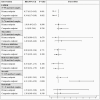Role of Low-Molecular-Weight Heparin in Hospitalized Patients With Severe Acute Respiratory Syndrome Coronavirus 2 Pneumonia: A Prospective Observational Study
- PMID: 33365358
- PMCID: PMC7717381
- DOI: 10.1093/ofid/ofaa563
Role of Low-Molecular-Weight Heparin in Hospitalized Patients With Severe Acute Respiratory Syndrome Coronavirus 2 Pneumonia: A Prospective Observational Study
Abstract
Background: This study was conducted to evaluate the impact of low-molecular-weight heparin (LMWH) on the outcome of patients with severe acute respiratory syndrome coronavirus 2 (SARS-CoV-2) pneumonia.
Methods: This is a prospective observational study including consecutive patients with laboratory-confirmed SARS-CoV-2 pneumonia admitted to the University Hospital of Pisa (March 4-April 30, 2020). Demographic, clinical, and outcome data were collected. The primary endpoint was 30-day mortality. The secondary endpoint was a composite of death or severe acute respiratory distress syndrome (ARDS). Low-molecular-weight heparin, hydroxychloroquine, doxycycline, macrolides, antiretrovirals, remdesivir, baricitinib, tocilizumab, and steroids were evaluated as treatment exposures of interest. First, a Cox regression analysis, in which treatments were introduced as time-dependent variables, was performed to evaluate the association of exposures and outcomes. Then, a time-dependent propensity score (PS) was calculated and a PS matching was performed for each treatment variable.
Results: Among 315 patients with SARS-CoV-2 pneumonia, 70 (22.2%) died during hospital stay. The composite endpoint was achieved by 114 (36.2%) patients. Overall, 244 (77.5%) patients received LMWH, 238 (75.5%) received hydroxychloroquine, 201 (63.8%) received proteases inhibitors, 150 (47.6%) received doxycycline, 141 (44.8%) received steroids, 42 (13.3%) received macrolides, 40 (12.7%) received baricitinib, 13 (4.1%) received tocilizumab, and 13 (4.1%) received remdesivir. At multivariate analysis, LMWH was associated with a reduced risk of 30-day mortality (hazard ratio [HR], 0.36; 95% confidence interval [CI], 0.21-0.6; P < .001) and composite endpoint (HR, 0.61; 95% CI, 0.39-0.95; P = .029). The PS-matched cohort of 55 couples confirmed the same results for both primary and secondary endpoint.
Conclusions: This study suggests that LMWH might reduce the risk of in-hospital mortality and severe ARDS in coronavirus disease 2019. Randomized controlled trials are warranted to confirm these preliminary findings.
Keywords: ARDS; COVID-19; SARS-CoV-2; low-molecular weight; mortality.
© The Author(s) 2020. Published by Oxford University Press on behalf of Infectious Diseases Society of America.
Figures

References
-
- World Health Organization. Novel coronavirus. Available at: https://www.who.int/emergencies/diseases/novel-coronavirus-2019/situatio.... Accessed 7 December 2020.
LinkOut - more resources
Full Text Sources
Miscellaneous

